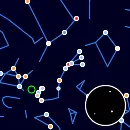Double Star 17589-3652 Observation Details

17589-3652 Daily Motion
17589-3652 will be visible until November, 4, when it will move too close to the Sun. During this time, its proximity to the Sun will cause it to disappear from the night sky, making it unobservable for a while.
17589-3652 Visibility Timetable on August 13
17589-3652 Rise and Set Timetable
| Time | Elevation | |
| 17589-3652 rise | 15:29 | |
| Sunset | 19:07 | 41° |
| Civil sunset | 19:29 | 44° |
| Astrosession begin | 20:19 | 50° |
| 17589-3652 transit | 21:28 | 53° |
| Moon Rise, 75.6% illuminated | 22:41 | 49° |
| 17589-3652 set | 03:27 | |
| Astrosession end | 05:50 | -28° |
| Moon Set | 11:07 | -46° |
Track 17589-3652 Position Throughout the Night
← Wed, 13 August 2025 →
| Time | |
| Altitude | |
| Azimuth |
Shift the map to change the time and observe 17589-3652 changing position in the night sky.
17589-3652 Star System Description
17589-3652 is Triple Star System located in constellation Scorpius at coordinates RA: 17h 58m 55s", Dec: -36° 51' 30s.
The primary component has a magnitude of 5.84, while the secondary component has a magnitude of 7.75. They are separated by 47.1 arcseconds at a position angle of 265 degrees. The brightness difference between the two components is 1.91 magnitudes, with the primary component being approximately 5.8 times brighter than the secondary.
Below is a table with star system details from the Washington Double Star (WDS) Catalog. This catalog is a comprehensive source of information on double and multiple star systems, providing key data on the positions, magnitudes, and separations of stellar components.
The primary component has a magnitude of 5.84, while the secondary component has a magnitude of 7.75. They are separated by 47.1 arcseconds at a position angle of 265 degrees. The brightness difference between the two components is 1.91 magnitudes, with the primary component being approximately 5.8 times brighter than the secondary.
Below is a table with star system details from the Washington Double Star (WDS) Catalog. This catalog is a comprehensive source of information on double and multiple star systems, providing key data on the positions, magnitudes, and separations of stellar components.
Technical Details of Star System 17589-3652
| Property | Value |
|---|---|
| Star System Identifier | 17589-3652 |
| System Type | Triple Star System |
| Primary Star | Sco-17589-3652 |
| Right Ascension (RA) | 17.98211 (17h 58m 55s") |
| Declination (Dec) | -36.85839 (-36° 51' 30s) |
| Magnitude (Primary) | 5.84 |
| Magnitude (Secondary) | 7.75 |
| Spectral Type (Primary/Secondary) | G8III |
| Separation (Arcseconds) | 47.1 |
| Position Angle | 265° |
| Discovery Year | 1836 |
| Last Observed | 2016 |
| Primary Proper Motion (Ra, Dec) | +011+014 |
| Secondary Proper Motion (Ra, Dec) | -014-047 |
| Number of Observations | 23 |
17589-3652 Components
| Component | Magnitude | Separation (arcseconds) | Position Angle |
| AB | 7.75 | 47.1 | 265 |
| AC | 11.3 | 41.2 | 173 |
The data presented in this table is sourced from the Washington Double Star (WDS) Catalog, a comprehensive repository of double and multiple star system information maintained by the U.S. Naval Observatory. We thank the WDS team for their continued efforts in providing accurate and detailed astronomical data.
Finder Chart for
Double-click to unlock the map.
| Object name | 17589-3652 |
| Field of view | |
| Limiting magnitude | |
| 17589-3652 coordinates | 17.98211, -36.85839 |
| Center coordinates | 17.98211, -36.85839 |
17589-3652 Passage Through Night
Double-click to unlock the map.
Current position of 17589-3652
| Time | 00:08 |
| Latitude | 0 |
| Longitude | 0 |
| 17589-3652 elevation | 38° |
| 17589-3652 Azimuth | 139° |
Here you can see the current position of the 17589-3652 on the map, as well as its positions for rise and set. This tool allows you to track the 17589-3652's movement throughout the night, providing you with accurate and up-to-date information.
Annual motion of 17589-3652
| Date | Thu, 14 August 2025 |
| Twighlight start | 20:15 |
| Twighlight end | 05:45 |
| Twighlight duration | 9h 30m |
| Rise | 15:25 |
| Set | 03:23 |
| Elevation at transit | 53° |
| Transit time | 21:24 |
| Equatorial coordinates | RA: 17h 58m 55s", Dec: -36° 51' 30s |
| Magnitude | 6 |
| Constellation | Scorpius |
The graph illustrates the annual visibility pattern of a 17589-3652, providing a comprehensive overview of its daily appearances and transit times throughout the year.
The graph is structured with the vertical axis showing the hours of the day, ranging from 12 AM to 12 AM the next day, while the horizontal axis spans each day of the year.
The reddish shaded area indicates the periods when the 17589-3652 is above the horizon, visible to observers. The white line marks the times when the celestial object reaches its highest point in the sky each day, known as the transit.
The graph is structured with the vertical axis showing the hours of the day, ranging from 12 AM to 12 AM the next day, while the horizontal axis spans each day of the year.
The reddish shaded area indicates the periods when the 17589-3652 is above the horizon, visible to observers. The white line marks the times when the celestial object reaches its highest point in the sky each day, known as the transit.
